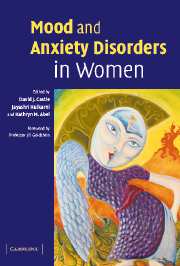Book contents
- Frontmatter
- Contents
- Contributors
- Preface
- Foreword
- 1 Pubertal development and the emergence of the gender gap in mood disorders: A developmental and evolutionary synthesis
- 2 Borderline personality disorder: Sex differences
- 3 Substance use and abuse in women
- 4 Anxiety disorders in women
- 5 Posttraumatic stress disorder in women
- 6 Domestic violence and its impact on mood disorder in women: Implications for mental health workers
- 7 Depression in women: Hormonal influences
- 8 Anxiety and mood disorders in pregnancy and the postpartum period
- 9 Pharmacological treatment of anxiety and depression in pregnancy and lactation
- 10 Bipolar affective disorder: Special issues for women
- 11 Mood and menopause
- 12 Anxiety and depression in women in old age
- Index
4 - Anxiety disorders in women
Published online by Cambridge University Press: 13 August 2009
- Frontmatter
- Contents
- Contributors
- Preface
- Foreword
- 1 Pubertal development and the emergence of the gender gap in mood disorders: A developmental and evolutionary synthesis
- 2 Borderline personality disorder: Sex differences
- 3 Substance use and abuse in women
- 4 Anxiety disorders in women
- 5 Posttraumatic stress disorder in women
- 6 Domestic violence and its impact on mood disorder in women: Implications for mental health workers
- 7 Depression in women: Hormonal influences
- 8 Anxiety and mood disorders in pregnancy and the postpartum period
- 9 Pharmacological treatment of anxiety and depression in pregnancy and lactation
- 10 Bipolar affective disorder: Special issues for women
- 11 Mood and menopause
- 12 Anxiety and depression in women in old age
- Index
Summary
Anxiety is a common human experience, and ranges in depth and intensity. The experience is most typically in response to life stressors, and may be temporary. However, many people experience anxiety symptoms in association with a diagnosable mental illness. Individuals with an anxiety disorder are functionally impaired by the condition that is beyond a reasonable temporary response to trauma, stress or danger.
Anxiety disorders are common in that 19% of men and 31% of women will develop some type of anxiety disorder during their lifetime (Kessler et al., 1994a). The US National Comorbidity Survey (NCS), a community prevalence study, found the following risk factors to be associated with a lifetime anxiety disorder: lower income, less education, living in the northeast and female sex. The likelihood of developing an anxiety disorder was 85% higher in women than men. Although there are many characteristics that differ among the anxiety disorders, the greater risk associated with being female is consistent across the various types of pathological anxiety. In this chapter, we review sex differences in the epidemiology, clinical characteristics and illness course for the anxiety disorders. Additionally, we discuss the influence of the premenstruum as well as gestation and delivery on the expression of anxiety disorders. We do not specifically address treatment issues; the reader is referred to Chapters 5, 8 and 9 for consideration of treatment issues pertinent to women.
Panic disorder
Panic disorder is a pattern of brief but intense recurrent episodes of fear or discomfort that occur without a notable precipitant.
Keywords
- Type
- Chapter
- Information
- Mood and Anxiety Disorders in Women , pp. 59 - 74Publisher: Cambridge University PressPrint publication year: 2006
- 2
- Cited by



